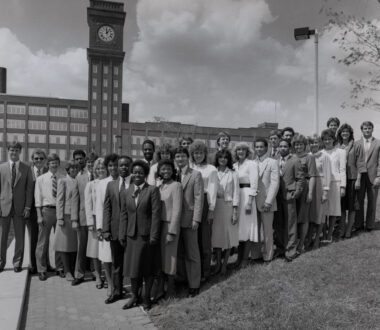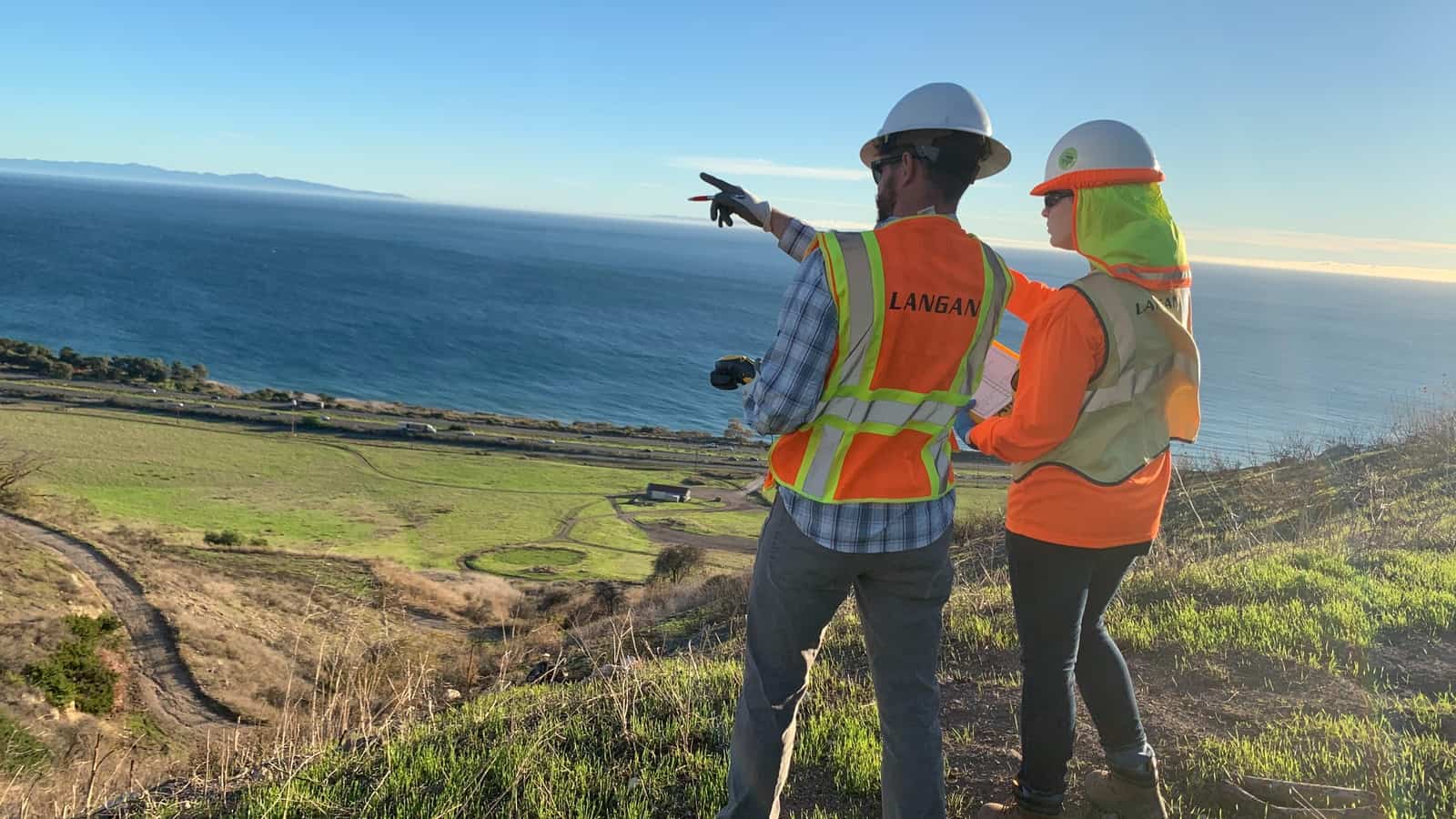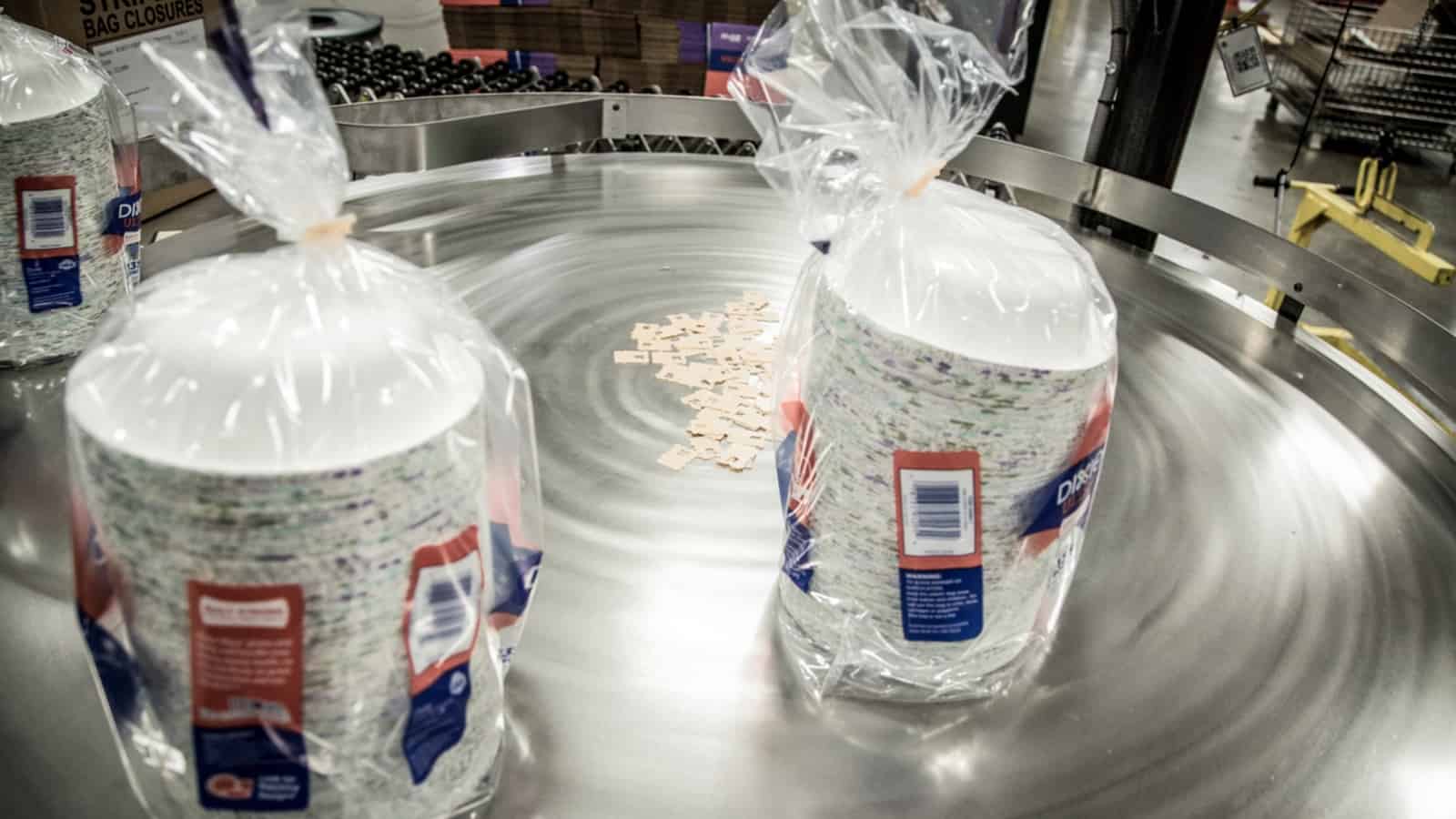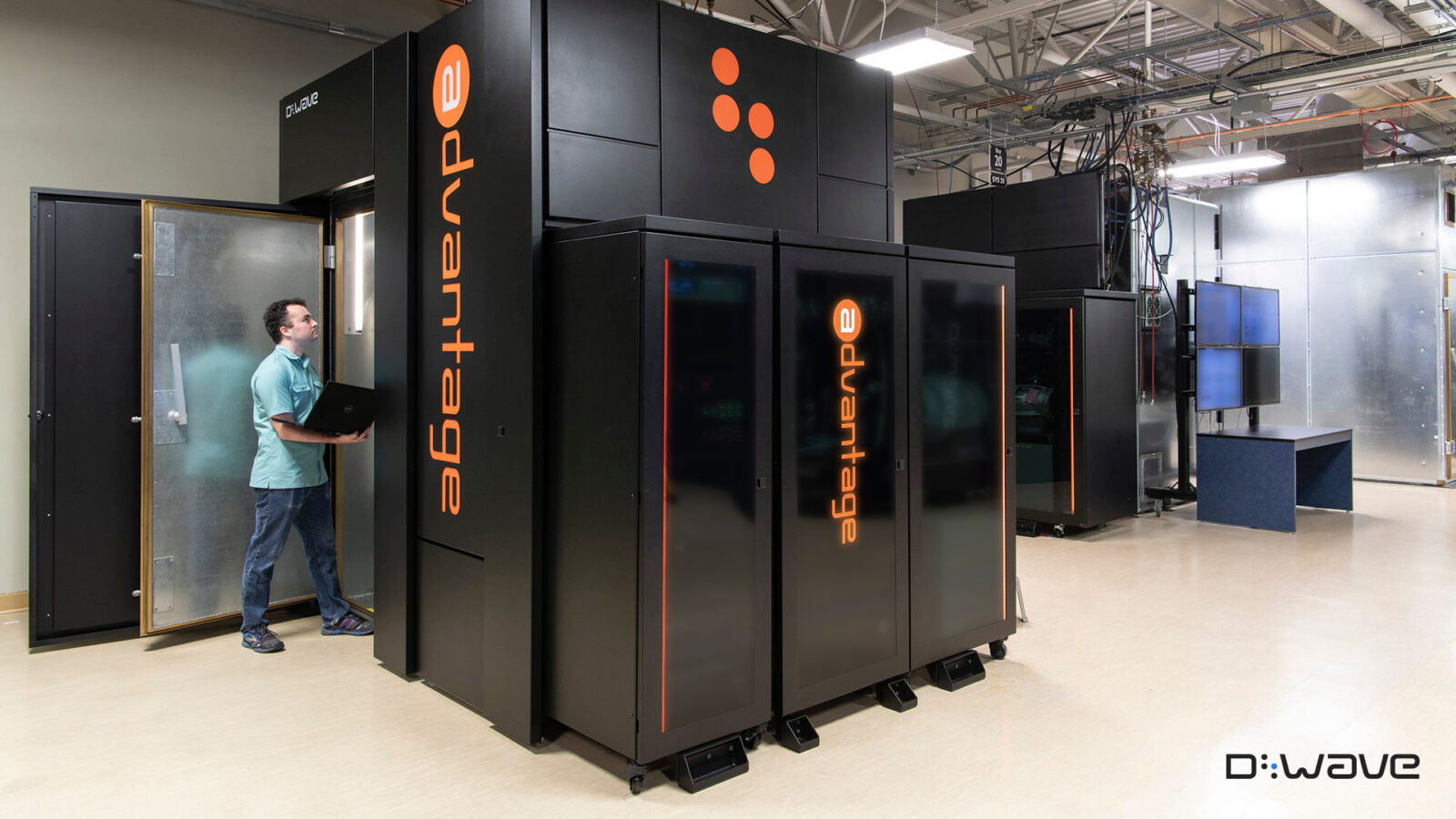How Goodyear and Akron Thrive Together

This year, one of the most recognizable brands in America turned 125. Goodyear, the manufacturer of tires for everything from cars to planes to lunar rovers, celebrated its anniversary in style, including by flying the famous blimps over its hometown of Akron, Ohio.
The company’s deep ties to Akron have been apparent throughout its more than a century in business. We spoke to Senior Vice President and Chief Communications Officer Laura Duda recently about that history and what other manufacturers can learn from it.
The beginning: Goodyear was founded in 1898, when F.A. “Frank” Seiberling purchased two empty factories in Akron’s then-small downtown, Duda told us.
- The company brought thousands of jobs to the neighborhood known as Middlebury and is still operating there more than a century later, having built its new headquarters on Innovation Way in 2014, just blocks away from its previous headquarters.
- The company also built its largest innovation center in Akron around the same time, as well as one of its three airship bases. Its Akron facilities also include a plant that produces racing tires, a test track that helps the company develop and bring innovative products to market and much more—all in the place it first called home.
Growing together: In addition to creating and keeping jobs in Akron, Goodyear prides itself on its contributions to the expansion of the city throughout the company’s history, Duda said.
- Seiberling himself developed a neighborhood called Goodyear Heights, which offered affordable housing to the company’s workers and remains a beloved historic district today.
- Meanwhile, the city’s first municipal bus system was constructed to bring the company’s workers downtown to the factory, and Goodyear’s early leaders created the surrounding county’s public parks.
- “It’s not possible to separate the history of Akron from the history of Goodyear,” Duda concluded.
Recruiting locally: Ever since its founding, Goodyear has always prioritized local recruitment, said Duda, and worked to set employees up for long, productive tenures at the company.
- In 1913, Goodyear’s first CEO, Paul Litchfield, set up an early in-house training program called the “flying squadron,” which helped associates learn new skills and advance in their careers. Today, the descendant of that
 program is known as “Sales Squad,” Duda said, and serves to “attract talent to and kickstart the company.”
program is known as “Sales Squad,” Duda said, and serves to “attract talent to and kickstart the company.” - This program recruits recent college graduates for full-time positions across the country, using a 10-week training program designed to prepare candidates for a career at Goodyear by providing experiences within the company’s retail, sales, manufacturing and product development departments.
- Goodyear also offers developmental programs throughout the company, via a learning center that provides both in-person and take-home training resources.
- Lastly, the company collaborates with STEM programs in schools both in the Akron area and around the country, sending its engineers out to tell students about Goodyear’s many rewarding career paths.
Still giving back: Today, Akron is a well-established city with significant infrastructure, and Goodyear is still contributing to the city’s future.
- “It’s unusual to find an area of community support where Goodyear is not engaged,” said Duda. “We focus on building ‘safe, smart and sustainable communities.” The company’s “safe” pillar includes a partnership with Akron’s Children’s Hospital to provide car seats to parents who can’t afford them and bike helmets to older children. “Smart” projects include efforts to promote STEM careers among underrepresented students at Akron Public Schools.
- Meanwhile, Goodyear’s focus on sustainability has led it to support the development of the region’s Ohio & Erie Canalway Towpath Trail, along with green space throughout the region.

Blimps: We couldn’t have an interview with Goodyear without asking about the blimps, of course.
- Yes, Duda has ridden in them, she told us, and the experience is “as great as you would expect.”
- Akron also takes great pride in the blimps, which can be a major draw at charity auctions, to which the company often donates rides. A ride for two on a blimp “goes for more money than you might anticipate,” said Duda.
The last word: While it is hard to replicate the sort of community ties and goodwill built up over more than a century, Duda has some advice for manufacturing companies looking ahead to the next 125 years. Not only will they find local leaders very receptive to outreach, she advised, but an enormous amount gets accomplished at local associations and chambers of commerce.
- Just as importantly, manufacturers should know that “your employees want this [level of community engagement],” Duda said. “We hear from top talent that we are recruiting that it is important to them, as well as from our current employees. From a talent perspective, this is something everyone should consider.”
For more on Goodyear’s history, innovations and future plans, check out the company’s engrossing documentary made for the anniversary: 125 Years in Motion.
Environmental Firm Langan Takes on ‘Forever Chemicals’

The race to remove PFAS from its remaining industry uses is on—and according to Langan’s Stewart Abrams, must be “a sprint, not a jog.”
In high demand: Abrams is a principal and director of remediation technology at Langan, a national environmental and engineering firm. He leads the consulting firm’s remediation practice, specializing in the treatment of perfluoroalkyl and polyfluoroalkyl substances, chemical compounds that were used widely in household products—including fire extinguishers—for decades.
- It’s an area of expertise that will soon be highly sought after, given the Environmental Protection Agency’s proposal earlier this year of drinking water maximum contaminant levels (MCL) of 4 parts per trillion (ppt) for both PFOA and PFOS. This will not only affect drinking water but will become an important standard for remediation sites as well.
- Langan has clients—including property owners and developers—who focus on the removal of PFAS from contaminated groundwater.
“What’s possible”: “Part of what Langan is doing is focusing on what is possible” regarding PFAS removal, Abrams said.
- “We’re looking at the treatment of groundwater and drinking water. We’re also working on how to deliver existing and new technologies to site cleanup. We’re going to have to move faster than ever before to bring these technologies to the marketplace. It’s a sprint, not a jog.”
Land remediation: Langan has long worked with property developers, helping them clear land of contaminants before building begins. PFAS issues, however, have changed the game considerably.
- “Now we’re looking at projects [for clients] where the question is, ‘How do you use water or land that’s been PFAS-contaminated?’” Abrams said.
- “Some companies have legacy contamination at the sites” they want to build on, and solutions aren’t always forthcoming, he continued.
Airports and PFAS: Another significant Langan customer sector? The aviation industry. Since 2022, airlines operating at California airports may no longer use PFAS in firefighting foam, a common use of the compounds for many years owing to their fire-extinguishing capabilities.
- “They’ve had to adopt new methods of firefighting at [California] airports,” said Abrams of Langan’s aviation clients in that state. “It’s hard because you need a lot of this fluid to address a fire given the amount of fuel on an airplane. The problem is that often the large water reservoirs at these airports have until recently contained a lot of PFAS.”
- That contamination isn’t limited to the water, Abrams added, but extends to everything the PFAS has touched. “Everything in the [firefighting] systems—the pumps, the nozzles, the piping—are contaminated, as is the storage reservoir itself. Part of the complexity of removal is cleaning all of it and then finding an alternative” surfactant, a chemical compound that can effectively extinguish fire.
- In addition, the sponge-like concrete that often lines the reservoirs at airports may have absorbed the chemical, requiring removal and replacement.
Finding solutions: About a decade ago, Langan and the New Jersey Institute of Technology began an informal research partnership.
- Members of Langan’s staff have access to NJIT’s environmental engineering laboratories, where they can set up experiments to solve client challenges. Now the company is leveraging that relationship to find solutions to PFAS problems.
- The labs are “a great [place] to bring in new ways of doing things with PFAS,” Abrams told us. “We’re exploring new treatment methods, new characterization methods, and we will be working to accelerate those technologies to market.”
Taking practical action: The strong carbon-fluorine bonds in PFAS chemicals render them harder to destroy than other contaminants, Abrams noted.
- “Unlike with other compounds—particularly volatile organic compounds and chlorinated solvents—with PFAS, we can’t quite track down all of it,” he continued. “It’s out there in the environment; it would be extremely difficult to chase down every molecule. Instead, we want to bring a theme of pragmatism to PFAS cleanup.”
Creators Wanted Tour Sets New Records at Ohio Finale

The size of the Great Pumpkin at the 116th annual Circleville Pumpkin Show—Ohio’s iconic fall fest—wasn’t the only record shattered there last week. The Creators Wanted Tour, a historic initiative of the NAM and the Manufacturing Institute to build excitement about modern manufacturing careers, reached new highs for engagement at its 20th and final stop.
Driving the news: The show attracted a crowd of more than 400,000, with “Creators Wanted” the most prominent brand seen and heard throughout the entire event. Of show attendees, the Creators Wanted activation pulled in a tour record of 2,024 participants comprising students and chaperones, taking the immersive experience’s overall total to just shy of 17,000 in two years.
- The digital campaign surrounding the stop collected an additional 110,000 email signups from students and career mentors interested in learning more about modern manufacturing careers, bumping the campaign’s email list above 1.6 million.
- The tour stop also saturated local news, with NBC4, 10TV CBS and WTTE Fox all sending live crews to the experience.
Why it matters: The stop, sponsored by the joint venture of Honda and LG Energy Solution and in partnership with the Ohio Manufacturers’ Association, comes at a critical time for the nation’s manufacturers, as they compete against other industries to fill available job openings today and win the interest of young people for the careers of tomorrow.
- For example, Honda and LG Energy Solution need to hire 2,200 workers within two years for their new electrical vehicle battery plant in Fayette County, Ohio.
- At the stop, Honda and LG Energy Solution joint venture associates were on hand to provide information about modern manufacturing careers generally and about opportunities at the EV plant specifically. The traffic around the experience was so robust that all recruiting materials were exhausted before the event wrapped up.
Zoom in: On Saturday night, the Creators Wanted team also reinforced the industry’s commitment to communities by leading the largest parade of the show, in front of tens of thousands who heard the public address system broadcast the industry’s call for creators and highlight the campaign’s career resources at CreatorsWanted.org.
- NAM President and CEO Jay Timmons, a proud son of Circleville and Chillicothe, Ohio, also addressed an assembling of Ohio’s young women leaders and their families, emphasizing their capacity to make a difference in manufacturing careers while at the same time noting mentorship resources available to them through the MI’s Women MAKE America initiative.
- The tour’s innovative approach received strong approval from state and local officials, strengthening the campaign’s ability to reach students and constituents. Ohio Treasurer Robert Sprague, State Auditor Keith Faber, State Sen. Michele Reynolds and State Reps. Brian Stewart and Mark Johnson, among others, stopped by to see what the buzz was all about.

Tour highlights: Beyond the pumpkin-centric celebrations, the tour also took its message of opportunity and rewarding careers to the new, state-of-the-art Logan Elm School, a combined elementary, middle and high school, as well as to students of the Ohio State University’s Center for Design and Manufacturing Excellence.
- At Logan Elm, Timmons was joined by OMA President Ryan Augsburger, Honda and LG Energy Solution joint venture representative and engineer Sandip Suvedi and representatives from Sofidel America. Honda engineer Meredith Reffey, who is now Honda America’s department lead for workforce partnership, joined Timmons and MI President and Executive Director Carolyn Lee at OSU. (The MI is the workforce development and education affiliate of the NAM.)
The big number: Post-tour surveys show that 84% of participants now view the manufacturing sector more positively.
On the record: “Closing our expansive 20-stop, 25,000+ mile tour at such a dynamic event serves as a potent reminder: the heartbeat of manufacturing lies within our communities,” said Timmons. “It’s in the eyes of the young dreamers in the crowd, the hands of our diligent staff and the spirits of every individual who championed our journey.”
- “The Creators Wanted Tour helped us shift perceptions, but we also know the hard work of continuing to improve perceptions and build the workforce of the future goes on,” said Lee. “The Manufacturing Institute, with our scaled-up efforts to drive solutions with manufacturers and across the industry and the robust digital network and resources the campaign has created will build on the tour’s momentum to do even more.”
The last word: “Our aspiration with Creators Wanted was straightforward yet audacious: to transcend traditional boundaries, step out of the corridors of Washington, D.C., and engage directly with communities across the country,” said NAM Managing Vice President of Brand Strategy Chrys Kefalas. “That’s exactly what we and the manufacturers who joined this tour and campaign did, and we’ve made a lasting positive difference in people’s lives that will outlive this tour and help the industry for decades to come.”
Creators Wanted Tour Sets New Records at Ohio Finale

The size of the Great Pumpkin at the 116th annual Circleville Pumpkin Show—Ohio’s iconic fall fest—wasn’t the only record shattered there last week. The Creators Wanted Tour, a historic initiative of the NAM and the Manufacturing Institute to build excitement about modern manufacturing careers, reached new highs for engagement at its 20th and final stop.
Driving the news: The show attracted a crowd of more than 400,000, with “Creators Wanted” the most prominent brand seen and heard throughout the entire event. Of show attendees, the Creators Wanted activation pulled in a tour record of 2,024 participants comprising students and chaperones, taking the immersive experience’s overall total to just shy of 17,000 in two years.
- The digital campaign surrounding the stop collected an additional 110,000 email signups from students and career mentors interested in learning more about modern manufacturing careers, bumping the campaign’s email list above 1.6 million.
- The tour stop also saturated local news, with NBC4, 10TV CBS and WTTE Fox all sending live crews to the experience.
Why it matters: The stop, sponsored by the joint venture of Honda and LG Energy Solution and in partnership with the Ohio Manufacturers’ Association, comes at a critical time for Ohio and the nation’s manufacturers, as they compete against other industries to fill available job openings today and win the interest of young people for the careers of tomorrow.
- For example, Honda and LG Energy Solution need to hire 2,200 workers within two years for their new electrical vehicle battery plant in Fayette County, Ohio.
- At the stop, Honda and LG Energy Solution joint venture associates were on hand to provide information about modern manufacturing careers generally and about opportunities at the EV plant specifically. The traffic around the experience was so robust that all recruiting materials were exhausted before the event wrapped up.
Zoom in: On Saturday night, the Creators Wanted team also reinforced the industry’s commitment to communities by leading the largest parade of the show, in front of tens of thousands who heard the public address system broadcast the industry’s call for creators and highlight the campaign’s career resources at CreatorsWanted.org.
- NAM President and CEO Jay Timmons, a proud son of Circleville and Chillicothe, Ohio, also addressed an assembling of Ohio’s young women leaders and their families, emphasizing their capacity to make a difference in manufacturing careers while at the same time noting mentorship resources available to them through the MI’s Women MAKE America initiative.
- The tour’s innovative approach received strong approval from state and local officials, strengthening the campaign’s ability to reach students and constituents. Ohio Treasurer Robert Sprague, State Auditor Keith Faber, State Sen. Michele Reynolds and State Reps. Brian Stewart and Mark Johnson, among others, stopped by to see what the buzz was all about.
Read the full story here.
How Manufacturers Can Unlock the Power of Data

Manufacturers are using data to improve everything from their supply chains to their workplace culture—and more. Data can lead the way to new innovations, new business models and even new revenue streams. Yet, many manufacturing executives say they are not scaling data-driven use cases successfully, meaning that much of the information they do collect is going to waste.
So how can companies get the most out of their data and ensure they aren’t losing out on key insights?
A unique event hosted by the Manufacturing Leadership Council, the NAM’s digital transformation division, aims to answer these questions and more. “Manufacturing in 2030: The Coming Data Value Revolution,” which will be held on Dec. 6–7 in Nashville, Tennessee, will explore the ways manufacturers can unlock value from their data to boost productivity, value and competitiveness.
On the agenda: This event will have three key areas of focus:
- Data value: Attendees will learn what the future holds for data monetization, data ecosystems and data-driven innovation.
- People and process: They will also hear about the future workforce, including emerging and evolving job roles, data-driven leadership and data culture.
- Technology and data: And lastly, they will peek into a future where artificial intelligence, data visualizations and the industrial metaverse are part of our everyday manufacturing world.
M2030 agenda highlights: The presenters will also share practical insights that participants can put into action right away.
- In “Capturing Intelligence for Business Model Innovation,” IDC’s Bob Parker will examine digital maturity and the future of enterprise intelligence. Parker will explain how to create new business models through enhanced customer experience, as well as how to capture and leverage economies of intelligence.
- In “The Rise of Data Ecosystems,” John Dyck of the Clean Energy Smart Manufacturing Innovation Institute will deliver a practical explanation of Manufacturing-X, Gaia-X and Catena-X as well as their goals and challenges. Dyck will discuss trends driving data-sharing initiatives as well as related technical and governance issues.
- In “Building Great Supply Chain Visibility by 2030,” Supply Chain Insights’ Lora Cecere will address why 80% of the data being generated from supply chains isn’t being used well enough. Cecere will also explore how data can be used to create more resilient supply chains by 2030.
The bottom line: Advanced technologies are only part of the digital transformation story. Manufacturers who want to get ahead need to understand data’s role and value, not to mention how people, process, technology and even data itself will evolve by 2030.
Sign up: Registration is open for Manufacturing in 2030: The Coming Data Value Revolution. Click here to learn more.
How Manufacturers Can Unlock the Power of Data

Manufacturers are using data to improve everything from their supply chains to their workplace culture—and more. Data can lead the way to new innovations, new business models and even new revenue streams. Yet, many manufacturing executives say they are not scaling data-driven use cases successfully, meaning that much of the information they do collect is going to waste.
So how can companies get the most out of their data and ensure they aren’t losing out on key insights?
A unique event hosted by the Manufacturing Leadership Council, the NAM’s digital transformation division, aims to answer these questions and more. “Manufacturing in 2030: The Coming Data Value Revolution,” which will be held on Dec. 6–7 in Nashville, Tennessee, will explore the ways manufacturers can unlock value from their data to boost productivity, value and competitiveness.
On the agenda: This event will have three key areas of focus:
- Data value: Attendees will learn what the future holds for data monetization, data ecosystems and data-driven innovation.
- People and process: They will also hear about the future workforce, including emerging and evolving job roles, data-driven leadership and data culture.
- Technology and data: And lastly, they will peek into a future where artificial intelligence, data visualizations and the industrial metaverse are part of our everyday manufacturing world.
M2030 agenda highlights: The presenters will also share practical insights that participants can put into action right away.
- In “Capturing Intelligence for Business Model Innovation,” IDC’s Bob Parker will examine digital maturity and the future of enterprise intelligence. Parker will explain how to create new business models through enhanced customer experience, as well as how to capture and leverage economies of intelligence.
- In “The Rise of Data Ecosystems,” John Dyck of the Clean Energy Smart Manufacturing Innovation Institute will deliver a practical explanation of Manufacturing-X, Gaia-X and Catena-X as well as their goals and challenges. Dyck will discuss trends driving data-sharing initiatives as well as related technical and governance issues.
- In “Building Great Supply Chain Visibility by 2030,” Supply Chain Insights’ Lora Cecere will address why 80% of the data being generated from supply chains isn’t being used well enough. Cecere will also explore how data can be used to create more resilient supply chains by 2030.
The bottom line: Advanced technologies are only part of the digital transformation story. Manufacturers who want to get ahead need to understand data’s role and value, not to mention how people, process, technology and even data itself will evolve by 2030.
Sign up: Registration is open for Manufacturing in 2030: The Coming Data Value Revolution. Click here to learn more.
Commerce Updates Chip-Export Restrictions

The Biden administration announced broad updates to restrictions on U.S. exports of advanced computing and semiconductor-making equipment to China, according to Reuters (subscription).
What’s going on: “The measures are designed to prevent China from acquiring the cutting-edge chips needed to develop AI technologies such as large language models, which power applications such as ChatGPT but that U.S. officials say also have military uses that present a national security threat.”
- The updated interim final rules announced on Oct. 17 will go into effect Nov. 17 and will “reinforce the October 7, 2022, controls to restrict [China]’s ability to both purchase and manufacture certain high-end chips critical for military advantage,” according to a press release from the Commerce Department’s Bureau of Industry and Security.
Why it matters: “These controls were strategically crafted to address, among other concerns, [China]’s efforts to obtain semiconductor manufacturing equipment essential to producing advanced integrated circuits needed for the next generation of advanced weapon systems” and other technologies that “present U.S. national security concerns,” according to the BIS.
- In an effort to control a wider range of chips, Tuesday’s rules will focus on computing power only and will require companies to notify the U.S. government when they sell chips that come in just under restriction limits.
“Chiplets”: The rules also seek to address “chiplets,” in which small portions of a chip are spliced to make a full chip.
- “Analysts had expressed concern that Chinese firms could use such technology to acquire chiplets that stayed within the legal limits but that could later be assembled in secret into a larger chip that would break the rules,” according to Reuters.
The last word: “By imposing stringent license requirements, we ensure that those seeking to obtain powerful advanced chips and chip manufacturing equipment will not use these technologies to undermine U.S. national security,” said Assistant Secretary of Commerce for Export Administration Thea D. Rozman Kendler.
A Supply Chain Leader Supports Other Women in Manufacturing

When Carrie Shapiro began her career as an engineering student at the Georgia Institute of Technology, she didn’t expect to work in manufacturing—but the moment she walked into a manufacturing facility near her school for an interview, she was hooked.
“I’ve had so many opportunities in manufacturing that I never wanted to leave,” said Shapiro. “From the very beginning, I was able to keep learning and growing and making better relationships.”
Today, Shapiro serves as the vice president of sourcing execution at Georgia-Pacific—a pulp and paper company—where she guides procurement and uses her expertise in supply chain operations to benefit the company’s 110 facilities. As a leader in the industry, she’s also focused on helping potential creators understand all that manufacturing has to offer.
A changing world: Shapiro’s role has been especially important over the past few years, as the COVID-19 pandemic and its aftermath forced companies to adjust their supply chains and react to shortages in real time. For Shapiro, that process required rethinking risks, using data effectively and focusing on achieving stability before optimization.
- “The mistake that we often make is we try to optimize something that’s not stable,” said Shapiro. “If you’ve got chaos in your supply chain, you have no business trying to optimize it. You have to stabilize first.”
A need for humans: As Shapiro notes, data has become more readily available than ever before, and new tools are helping organizations make smart adjustments in real time. Yet, human decision-making and critical thinking still have a vital role at the center of manufacturing.
- “Tools are great, software is great, tech is great—but it should be an enabler and not a magic wand,” said Shapiro. “You still have to know your process, understand your current state and know your capabilities across the supply chain to make effective decisions. Tools don’t absolve you from doing the real work of continuous improvement.”

Leading by example: At a time when women are underrepresented in the manufacturing industry, Shapiro feels a responsibility to help other women succeed.
- She serves as a mentor with Pathbuilders, where she helps high-achieving women reach their fullest potential. She also coaches young engineers in the Steven A. Denning Technology & Management Program at Georgia Tech and serves as a longstanding member of the Next Generation Manufacturing Women’s Roundtable.
- “One of the most important roles that I play is to be a visible leader and to show there is a path to leadership inside manufacturing as a female,” said Shapiro. “Having someone who looks like you in a leadership position really matters. That representation matters, and it’s meaningful to people coming up in the organization.”
- On the strength of her long record of mentorship, Georgia-Pacific has nominated Shapiro for a 2024 Women MAKE America award, given by the Manufacturing Institute (the NAM’s workforce development and education affiliate) to outstanding women in the field. (Stay tuned for the ceremony!)
The last word: Shapiro encourages other manufacturing leaders to be active in lifting up individuals who might otherwise be overlooked.
- “I’ve had incredible supervisors who have pulled me up through the organization, who saw something in me that I didn’t see in myself,” said Shapiro. “Sometimes people look at a candidate and think they might be a stretch for the position—but they may just not look like a traditional candidate.”
A Supply Chain Leader Supports Other Women in Manufacturing

When Carrie Shapiro began her career as an engineering student at the Georgia Institute of Technology, she didn’t expect to work in manufacturing—but the moment she walked into a manufacturing facility near her school for an interview, she was hooked.
“I’ve had so many opportunities in manufacturing that I never wanted to leave,” said Shapiro. “From the very beginning, I was able to keep learning and growing and making better relationships.”
Today, Shapiro serves as the vice president of sourcing execution at Georgia-Pacific—a pulp and paper company—where she guides procurement and uses her expertise in supply chain operations to benefit the company’s 110 facilities. As a leader in the industry, she’s also focused on helping potential creators understand all that manufacturing has to offer.
A changing world: Shapiro’s role has been especially important over the past few years, as the COVID-19 pandemic and its aftermath forced companies to adjust their supply chains and react to shortages in real time. For Shapiro, that process required rethinking risks, using data effectively and focusing on achieving stability before optimization.
- “The mistake that we often make is we try to optimize something that’s not stable,” said Shapiro. “If you’ve got chaos in your supply chain, you have no business trying to optimize it. You have to stabilize first.”
A need for humans: As Shapiro notes, data has become more readily available than ever before, and new tools are helping organizations make smart adjustments in real time. Yet, human decision-making and critical thinking still have a vital role at the center of manufacturing.
- “Tools are great, software is great, tech is great—but it should be an enabler and not a magic wand,” said Shapiro. “You still have to know your process, understand your current state and know your capabilities across the supply chain to make effective decisions. Tools don’t absolve you from doing the real work of continuous improvement.”
Read the full story here.
How Quantum Computing Can Combat “Forever Chemicals”

What sort of computer can evaluate 67 million potential solutions in 13 seconds? Only a quantum computer. But what sort of problem has 67 million solutions to begin with?
Many manufacturing challenges do, from optimizing supply chain logistics to finding the most efficient way to load millions of pallets. In recent years, another mind-bendingly complex problem has begun to occupy the industry: how to get potentially dangerous chemicals in a category known as PFAS out of use and out of our environment.
Quantum computing firm D-Wave says that quantum holds the key, as its massive computing power could find new ways to remove or remediate the chemicals, or even help identify which of the thousands of chemicals in this class are indeed dangerous. We recently spoke to D-Wave Global Government Relations and Public Affairs Leader Allison Schwartz to get the details.
How it works: As Schwartz explains it, quantum is “a completely different form of computing.”
- “Due to superpositioning and quantum entanglement, quantum can look at all possibilities at once and come back with an answer very quickly,” she said, in a way that classic computers just can’t match.
- However, some of the best solutions are a product of both classic computers and quantum, an option known as “hybrid” applications. For example, Davidson Technologies collaborated with D-Wave to create a hybrid solution that produced the aforementioned 67 million scenarios in 13 seconds.
- “Classical computing alone can’t do that,” Schwartz observed.
When quantum meets PFAS: So how does this help with PFAS? Schwartz told us that there are two different types of quantum computing that would prove useful.
- The first, annealing quantum computing systems, are superior at providing optimized solutions. These systems can quickly run through millions of scenarios that model potential chemical spills, methods of remediating the chemicals, techniques for removing them from operations entirely and much more. These systems are commercially available today through the cloud.
- Meanwhile, gate model systems offer another avenue for dealing with PFAS—they can potentially invent alternative molecules that could substitute for the dangerous chemicals. However, gate-model systems are not large enough yet to tackle real-world problems.
Doing the research: Quantum could also play a role in determining which chemicals are harmful in the first place, added Schwartz. There are thousands of PFAS chemicals out there, but so far, only a few hundred have been studied.
- To examine the effects of various chemicals, researchers and companies will have to undertake clinical trials. Quantum can help optimize the organization of those trials, as well as aid in analyzing the results—for example, by assisting with medical imaging reconstruction.
So what’s the holdup? With such a powerful tool at the ready, you might think policymakers would be jumping at the chance to encourage its use. In fact, quantum has yet to be used in a PFAS-related application, though Sens. Gary Peters (D-MI) and Joni Ernst (R-IA) mentioned its use in 2019 legislation later incorporated into the 2021 National Defense Authorization Act.
- However, “The EPA or DOE could recommend using quantum to optimize the PFAS work. It doesn’t need a legislative fix,” Schwartz noted. Instead, policymakers are more focused on finding replacement chemicals, a process that could take years, while incremental solutions could have a huge effect today.
- “Policymakers are relying on manufacturers to address the problem, but they aren’t providing insight into how emerging technology, such as quantum computing, can help manufacturers better achieve success,” said Schwartz.
Making quantum work for you: For manufacturers looking at quantum as a potential problem-solver, whether for PFAS or something else, Schwartz explained how D-Wave approaches new clients.
- First, a company’s leaders sit down with consultants at D-Wave, who conduct an in-depth examination of its operations—for example, by investigating which PFAS chemicals might be in use, how remediation might be accomplished or how contamination should be modeled.
- Once a problem or problems are identified, D-Wave builds a demo to test out potential options. It might build a custom algorithm or even a digital twin, as it did in partnership with SavantX to optimize container loading at the Port of Los Angeles. This step helps to hone the algorithm so it can find the right solutions for the manufacturer’s specific problem.
- Then D-Wave will work with the manufacturer to pilot the solution, making sure it functions as expected.
- And finally, the solutions are integrated into the production process and become part of daily operations.
The last word: “Tackling PFAS is a multipronged effort that calls for industry, academic and government collaboration,” said D-Wave CEO Dr. Alan Baratz. “Instead of waiting for a replacement chemical that could be years away, it is time to break down this societal problem and identify which parts of the problem can be addressed with quantum technology today.”